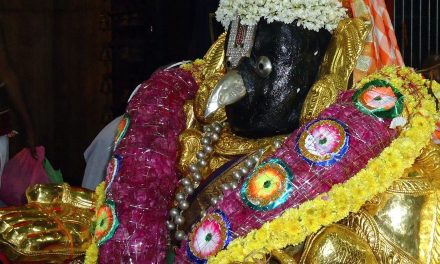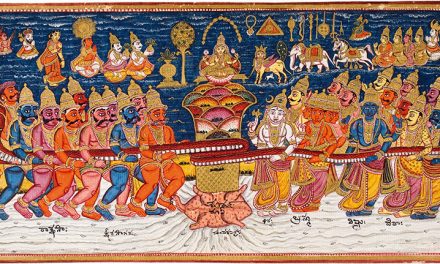In the Huzurnagar taluq, Nalgonda District of Andhra Pradesh is the town of Mattapalli, which is home to another famous temple of Lord Narasimhadeva. Here, Sri Lakshmi Narasimha Swami (also known as Sri Yogananda Lakshmi Narasimha Swamy) resides in His maha kshetram cave dwelling beside the Krishna River. The other presiding Deities of Mattapalli dhama are Sri Raajyalakshmi Thaayar and Sri Chenchu Lakshmi Thaayar, who are present alongside Lord Narasimha.
Mattapalli is the centre of a cluster of Nrsimhadev temples, which are placed in all four directions: Vedadri, Vadapally, Vethapuram and Mangalagiri. Together, the five temples are known as the Pancha Narasimha Kshetras.The importance of Mattapalli Kshetram is seen in this verse:
ekameva kshetram, mattapalli kshetram,
na anyat kshetram, mattapalli tulyam,
ekameva tatvam, mattapalli naatham,
na anyat tatvam, palli Simha tulyam
“Mattapalli is the only pilgrim spot. There is no secondary whatsoever and there is no equal to it. There is only one Lord and He is the Lord of Mattapalli. There no secondary whosoever and none is comparable to him.”
History of the Mattapalli Kshetra
The Lord has been radiating glory from the Mattapalli cave kshetra since time immemorial. Originally, Lord Nrsimhadeva was worshipped here only by the rishis and devas. Sri Bharadwaaja Maharshi worshipped the Deity here every day, accompanied by various other sages.
Later, during the Kali Yuga, the Lord appeared to a local devotee named Machireddi in a dream, telling him the location of His transcendental abode. Sri Anumala Machireddi was the ruler of Thangeda, which is located a few km from Mattapalli, on the opposite bank of the Krishna river. The Lord instructed Machireddi that his above could be identified by a tree, the Vedapatri. The Lord instructed Machireddi to open up the cave so that other devotees could also worship him.
The Maha Kshetram is located in the midst of a dense and lovely forest. At first, Machireddi and the pandits who accompanied him were unable to locate the Vedapatritree amongst the others in the forest. Finally, the Lord appeared in Machireddi’s dream and pressed him to search further, near an “Aare” tree hidden behind the foliage. Machireddi came across a beautiful and effulgent bird seated in the tree. A monkey then led him to the exact place in the face of the mountain that needed to be cleared and opened.
Inside the cave, the Deity of Sri Lakshmi Narasimha Swami was found in a seated posture, under the protection of Sesha naga’s hooded head, fully adorned with Shankha Chakra Gadha. As if the Lord was being worshipped regularly, flowers, sacred leaves, fruits, etc. were also found there. Overjoyed, Machireddi then revealed the Maha Kshetram to the general public and constructed a Mukhaalaya.
Physical
The sanctum sanctorium of Sri Mattapali Kshetram is located inside the cave, facing west. As soon as one moves down the narrow passage, they immediately come face-to-face with Sri Narasimha Swami. A bas-relief silver kavacham displays the Lord’s fierce lion form and features a prominent moustache.
Along the wall next to the Lord is His consort, Srimati Rajalakshmi. On her right can be seen a passage in the rock face. Now blocked, the passage at one time lead out of the cave, to the river. By this path, Bharadwaja came each day to worship the Deity. A few years ago, the river flooded up the passage and engulfed the Lord.
The temple’s mukha mantapam has 21 pillars with a cement roof. Before the Vaikunta dvaara (north door) there is a mantapa with five pillars and a cement roof that was built in the 1970’s. It measures 21feet x 18 feet. The mukhamantapam in front of the sanctum measures 24 feet x 45 feet and is about 20 feet high.
Because the sanctum cannot be circumambulated, the devotees perform pradakshinam by going around the Dhwajasthambha, where a stone murti of Hanuman faces the Lord. There is also a Ramanuja Kutam (madapalli or kitchen) to the north of the temple on the same premises, where the naivedya to the Lord is prepared.
There is an entrance to the temple which faces the south, and a series of steps leading down to the river Krishna, just outside the main temple but within the compound.
Description of the Garbhagriha (sanctum sanctorum):
In the Garbhagriha, or sanctum sanctorum, there is a rock above the door into which is carved a motif of Gaja Lakshmi with two elephants raising their trunks upwards on either side. The roof of the Garbhagriha the rock cave wall.
The Lord manifested Himself on a rock, which is located on the backside of the Garbhagriha. Another rock is spread like the hood of Sesha over it. The Form of the Lord is 1 foot in height. He is seated in Padmasana, holding a chakra in His upper right hand and Sankha in His upper left hand. His lower left hand is on His left knee, and His lower right hand is not visible.
On the left side of the Lord are three Namams (Thirumann), and two eyes which are understood to be the Form of Prahlada Maharaja. A small, lengthy rectangular rock of about 1 foot is positioned at the feet of the Lord, and it is said to be “Chakri”, an ardent devotee of the Lord who was not given mukti when he requested it, because the Lord did not want to be separated from him. Instead, the devotee was made into a rock-like form and placed in the sanctum. Daily abhishekam is performed for this personality, also.
To the left of the manifested Lord there is a black stone image of Lakshmi devi that is 1.5 feet in height. Sitting on a lotus, she holds lotus flowers in her upper hands while her lower right hand is in Abhaya posture, and the left hand is in Suchi posture.
Below this Lakshmi image there is another image of Lakshmi, which is carved into a rock. This Lakshmi is not visible to the visitors, but the image of Rajya Lakshmi is installed for the darshan of the devotees. She holds the chakra, sankha and lotus and is in sitting posture. This Laksmi form measures 1.25 feet in height, and she wears a makuta on Her head. Elsewhere there are copper images of Sudarsana, Nammazhwar and another Azhwar.
To the right side of the sanctum, leading to the north door are eleven black stone images of the Azhwars, seven of which face the west while the remaining four face east. There is a trench on the left side of the Lord at some distance in the cave, which it is believed to lead to the river Krishna through an underground passage.
Temple Traditions and Festivals
Major celebrations take place at Sri Yogaswami kshetra during the Vykunta Ekadasi in January and at Kalyana Mahotsvam in May. Vaikhaanasa Aagama is followed here, and the priest is a Sri Vaisnava hereditary priest. The temple closes each day at 12.30 p.m. and opens briefly before 1.30 p.m. for a final aarthi and distribution of prasadam. The temple does not open in the evenings, for that time is reserved for sacred worship by the rishis.
On the occasion of the Brahmotsavas, Mukkoti Ekadasi and Nrsimha Jayanthi, about 5,000 devotees from local and distant places congregate to worship. During festival days one-act-plays, dramas, dances, harikatha, bhajan and songs are provided for the pleasure of the Lord and the enrichment of the devotees. Prasadam is distributed to all the pilgrims.












